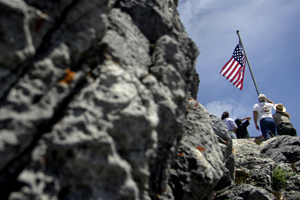
Governor threatens to lock up Fremont Peak, Henry Coe
As civilization encroaches into the last undeveloped swaths of
California, visitors to Fremont Peak State Park have the
opportunity to see clearly something that is becoming increasingly
rare: the night sky.
Governor threatens to lock up Fremont Peak, Henry Coe
As civilization encroaches into the last undeveloped swaths of California, visitors to Fremont Peak State Park have the opportunity to see clearly something that is becoming increasingly rare: the night sky.
The park is, “one of those few good dark sky places that people can really access,” said Doug Brown, president of the Fremont Peak Observatory Association, a non-profit that runs the observatory at the park.
“People can learn about nature in a way they couldn’t otherwise,” he said, referring to the park. “I remember when Haley’s Comet came around. We had thousands of people there.”
But if the budget proposed by Gov. Arnold Schwarzenegger is approved, the view from Fremont Peak is one that will be closed off to visitors, along with the wonders of many other state parks.
Gov. Schwarzenegger instructed staff from the California Department of Parks and Recreation (DPR) to cut their budget by up to 10 percent, and spread that reduction across the state, said Sheryl Watson, an information officer for DPR.
The proposed budget would close 48 areas that are managed by the DPR, including Fremont Peak State Park – the first place in the state where the California flag was raised – Henry W. Coe State Park and Fort Ord Dunes State Park, according to a release.
The number of lifeguards at state beaches would be cut, including New Brighton, Seacliff, Manresa, Natural Bridges and Sunset in Santa Cruz County. “Closing campgrounds at beaches is not part of the proposed budget,” Watson said.
The closures are not a certainty, she said. It depends on what the state’s final budget looks like.
The end of the fiscal year is June 30, Watson said.
“We will know what the final budget looks like at that time,” she said.
The closures would not happen all at once, Watson said. The process would start on June 30 and be complete a year later, she said.
The closed parks would still be patrolled, Watson said.
“If parks closed, the closed parks will be in caretaker status,” she said. “So at some point we will be able to reopen them.”
taker status,” she said. “So at some point we will be able to reopen them.”
Park rangers would still patrol the parks to keep out marijuana growers and vandals, she said.
“Our rangers have badges and guns, and they have powers of arrest,” Watson said. “They enforce the laws in our parks.”
Reducing services without closures was not an option, she said. It would make the parks unclean and unsafe, Watson said.
“We decided that this was really the only option available to us, in order to maintain the high level of necessary service that we provide,” she said.
Due to previous budget cuts, maintenance at the state parks, including building repair and trail maintenance, has been deferred since the 1980s, Watson said.
If the closures go through, “it would be taking away two things that I enjoy very much,” Brown said.
He joined the Fremont Peak Observatory Association more than 20 years ago, during construction of the observatory.
“I stumbled over to Fremont Peak,” Brown said, when he looked for a place to use a telescope.
It was a “serendipitous discovery,” he said. The Fremont Peak observatory is home to “Challenger,” a 30-inch reflecting telescope powerful enough to bring distant features of the night sky into close focus. It is open to the public from April through October on Saturdays that do not include a full moon, Brown said.
Visitors can use the telescope or attend an educational program, he said. Programs run from 30 to 60 minutes and instruct people about astronomical phenomena and the night sky, he said.
Members of the Association also offer an internship program through Hartnell College, he said.
“That’s really been quite helpful to a lot of the students,” Brown said, “They’ve made career choices based on what they’ve learned.”
Members also give presentations in schools around the Bay Area, he said.
It is mainly membership fees that fund the Association’s activities, Brown said. Visitors also make donations, he said.
“It’s something that we do because we love sharing astronomy with people, and sharing with people the wonders of the sky,” he said. “We kind of operate on a shoestring budget, but I think we do a very good job.”
Henry W. Coe State Park is the largest wilderness area in the state that is next to a major metropolitan area, said Winslow Briggs, a board member of the Pine Ridge Association, a nonprofit that is dedicated to maintaining the park.
Briggs literally wrote the book about Coe. Published in 2000, it is entitled, “The Trails of Henry W. Coe State Park.”
Coe is a little more than 89,000 acres of rugged wilderness punctuated by deep canyons and steep mountainsides in the Diablo Range. Mostly oak savanna, the landscape also includes chaparral, moist, fern gullies and a naturally occurring stand of ponderosa pines. “My wife and I have been volunteering there since 1977,” Briggs said.
He has done everything from emptying the recycling bins to leading hikes, he said.
When Briggs found out that the park might be closed, he was stunned.
“If I told you what I really think, I don’t think you could print it,” he said.
Hiking at Coe is different than at other parks, Briggs said. At Coe, people commonly see coyotes and bobcats. About once a month there is a mountain lion sighting.
“This is an experience the public can’t get very often,” Briggs said. “It’s usually limited to tame deer and marauding bluejays.”
For people who love Coe, being at the park, “is almost a spiritual experience for them. You close it, you take that away,” he said.
Closing the park would not keep people out, Briggs said.
“They’ll put gate barricades up,” he said. “There’s no way that is going to prevent bicyclists or even hikers from going in.”
“There are bike tracks all over the burn area, even though the area is closed,” Briggs said, of an area closed off since the Lick fire last fall.
There are archeological resources all over the park that would need to be protected, he said.
“They will have to patrol,” Briggs said. “Not that they can protect all of it.”
Without visitors to serve as the park’s eyes and ears, the problem of people growing marijuana in the park will increase, he said.
Henry W. Coe is a popular biking destination in the Bay Area, Briggs said. Unlike other parks, the trails at Coe are opened to bicycles unless the trail is labeled closed, he said.
Paul Nam is the director of Responsible Organized Mountain Peddlers (ROMP). He is at the park frequently, both as a bicyclist and a volunteer, he said.
“It takes years to get to know Coe when you’re visiting it two or three times per month,” Nam said. “And that would be a lot of times for most bicyclists.”
Coe has miles of trails to explore, he said.
More than 250 miles of trails are open to bicycles, Briggs said.
Referring to Coe, Nam said, “The more you know about it, the more variety you find.”
Nam does not believe that the government will shut Coe down, he said.
“I kind of think that it may be something that the government and the legislature is going to give back,” he said, “and make us feel good about the budget.”
The park has an intrinsic value for residents of the Bay Area, Nam said.
“Just knowing that there’s a place you can visit like that, that’s that size,” Nam said, “is part of the mental landscape of the Bay Area.”









